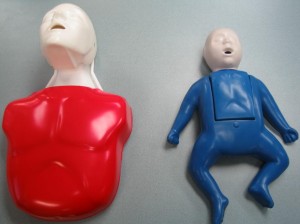Basic Life Support training programs

Basic Life Support training is available in all our training locations, found in six cities in the United States. When you enroll in our Basic Life Support courses, you will learn how to give CPR in emergency situations outside of an organized health care environment. Core CPR skills are the main focus of the BLS programs, with trainees learning how to perform chest compressions, ventilation, and defibrillation.
We have three basic courses available to trainees. One of them is for the general public – laypersons who do not work in health care or are not involved in health care on a day to day basis – and two for health care providers.
- Heartsaver CPR lasts four hours long and is tailored for people who do not work in health care. It is a basic program whose curriculum is focused on the three core CPR skills and one-person rescue.
- Heartsaver CPR C lasts four and a half hours long and tailors the first Heartsaver program for people who work in health care. It also focuses on one-person rescue.
- Basic Life Support for HCPs is more advanced than the Heartsaver programs, focusing on the three core skills but both one and two-person rescue. It runs for four and a half hours as well.
Out of the three programs, only the third – Basic Life Support for HCPs – has an available re-certification program. Re-certification classes allow rescuers to renew training credentials that are approaching expiry, not expired.
But why study CPR in the first place?
Heart disease is a dangerous problem in and out of the US. Over 600,000 deaths annually can be attributed to heart disease, with a quarter of that due specifically to coronary artery disease (CAD). CAD is a form of heart disease that affects the arteries that supply the heart with blood. In CAD, plaque builds up in the coronary arteries, obstructing the flow of blood through the vessels. Because blood flow is obstructed, the cardiac muscles aren’t receiving enough oxygen to function. The heart then starts to malfunction, causing arrhythmias and even eventual failure.
In the event of a heart attack, CPR helps restart the heart and return spontaneous circulation of blood in the body. Chest compressions will manually allow the heart to beat, ventilations will oxygenate the blood, and defibrillation will return the heart to regular heart rhythm.
Here are a few tips when giving CPR:
- Place both hands on top of each other in the middle of the chest, between the nipples.
- Push hard and push fast.
- When giving rescue breaths, tilt the head back and thrust the jaw downwards to open the airway.
- Give 30 chest compressions and 2 rescue breaths – this is one cycle. Repeat until EMTs arrive or the victim is brought to medical attention.
- Never defibrillate a victim who is experiencing a flat line (like what you see on TV and in movies). Defibrillation is only done on victims who experience severe arrhythmias, such ventricular tachycardia.
